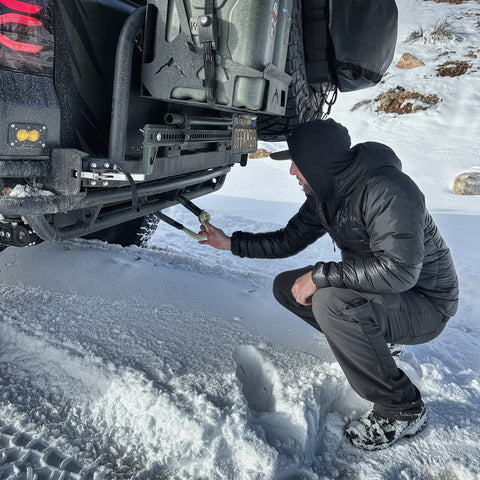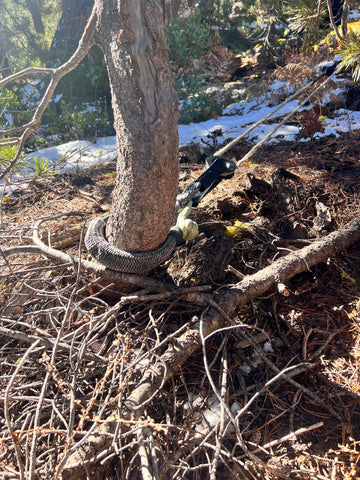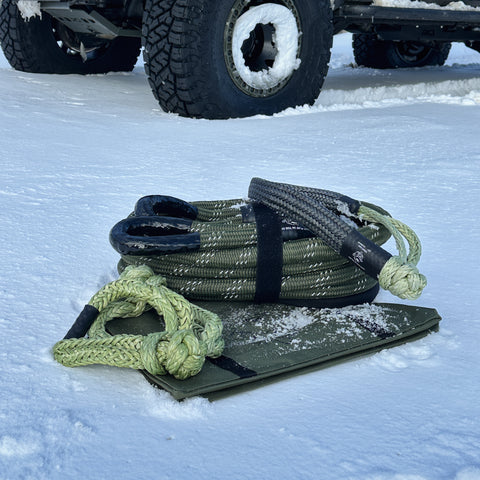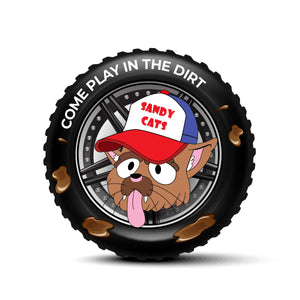Venturing into the great outdoors with a 4x4 vehicle is an experience that marries the thrill of exploration with the freedom of being secluded. However, even the most experienced off-roaders can find themselves stuck in a bind, be it a muddy ditch or a sandy berm. This is where the unsung heroes of vehicle recovery - shackles - come into play. Traditionally, steel shackles have been the go-to for many enthusiasts, but there's a new player in town that's changing the game: soft shackles.
Soft shackles, made from high-strength synthetic fibers, offer an innovative alternative to their steel counterparts. They are not only lighter and easier to handle but also introduce a new level of safety and versatility to recovery situations. This article delves into the world of soft shackles, exploring their benefits, use cases, and why they might just be the superior choice for your next 4x4 adventure.
The Advantages of Soft Shackles in 4x4 Recovery

Lightweight and Easy to Handle
One of the most significant benefits of soft shackles is their weight—or lack thereof. Traditional steel shackles are hefty, and when you're packing gear for an off-road trip, weight can get out of control quickly. Soft shackles are made from lightweight synthetic materials, which means they add minimal weight to your recovery kit. This makes them not only easier to store and transport but also reduces the physical strain during recovery operations.
The size of the loop that is formed makes attaching ropes and straps extremely easy. The excess space of the loop makes multi-strap or rope configurations, not a hassle like it is when trying to squeeze everything into a tight steel shackle.
Strength and Durability
Despite their featherweight nature, soft shackles boast incredible strength. Constructed from high-modulus polyethylene fibers, these shackles can handle tensile loads that rival and often exceed that of steel shackles. They are engineered to withstand the harsh conditions of off-roading, resisting abrasions, but standard soft shackles can be cut from rough/sharp surfaces. That’s why we developed our hitch hero soft shackle designed to be used against metal edges. Furthermore, they are impervious to corrosion, a common issue with metal shackles, ensuring a longer lifespan even in wet and salty environments.

Enhanced Safety Features
Safety is paramount in recovery situations, and soft shackles have a clear advantage here. Unlike steel shackles, if a soft shackle fails under extreme load, it does not become a projectile, which significantly reduces the risk of injury or vehicle damage. The lack of metal components also means there's no risk of sparking, a crucial consideration in dry or flammable conditions.
Versatility for Various Situations
Soft shackles are incredibly versatile due to their flexible nature. They can be easily wrapped around recovery points where rigid steel shackles cannot fit. This flexibility also allows for a more straightforward attachment to a variety of tow points, and they can be quickly loosened or tightened as needed. Moreover, their design eliminates the need for tools, which expedites the setup and dismantling process during recovery operations.
Environmental and Equipment Considerations
Another point worth noting is the environmental and equipment-friendly aspect of soft shackles. They are less likely to cause damage to the environment or to the recovery points on your vehicle. Their soft texture means they're gentler on tree trunks when used with a tree protector strap, and they won't chip the paint or dent the metal parts of your 4x4, preserving both the natural setting and your vehicle's integrity.
They will also float if you are operating in a water crossing situation. A steel shackle will sink and bury itself in the mud and most likely disappear leaving you stranded, but even if you have to chase down a floating soft shackle it can be recovered.

Let’s layout the pros and cons of soft shackles vs steel shackles
Soft Shackles: Revolutionizing Recovery
Pros:
- Lightweight and Compact: Soft shackles are significantly lighter than their steel counterparts, making them a breeze to carry, store, and handle. This is especially beneficial for overlanders who need to manage the weight and space of their gear.
- Strength and Safety: Made from high-strength synthetic fibers, soft shackles boast incredible tensile strength. They mitigate the risk of injury or vehicle damage if they fail under load, as they don't turn into dangerous projectiles like steel shackles might.
- Versatility: Their flexible nature allows soft shackles to be easily attached to various recovery points, including those where steel shackles can't fit. They're also quicker to connect and disconnect, saving precious time during recovery operations. They can also be connected to each other, unlike steel shackles.
- Environmental and Rig-Friendly: Soft shackles are less likely to damage the environment or your rig. They won't scratch paint, dent metal, or harm tree bark when used with a protector strap. Plus, they float, making them easier to retrieve in water crossings.
Cons:
- Durability Concerns: While highly resistant to tension, soft shackles can be susceptible to cuts, abrasion, and UV damage. Regular inspection and proper maintenance are essential to ensure their longevity.
- Cost: High-quality soft shackles can be more expensive upfront compared to traditional steel shackles, although the investment might be justified by their advantages.
Steel Shackles: The Traditional Choice
Pros:
- Rugged Durability: Steel shackles are incredibly tough and resistant to physical damage. They can handle rough, sharp edges and extreme loads without the risk of cutting or abrasion.
- Universal Compatibility: With a longstanding history in off-roading and recovery operations, steel shackles are widely recognized and compatible with most recovery gear setups.
- Cost-Effective: Steel shackles are generally less expensive than soft shackles, making them an accessible option for off-roaders and overlanders on a budget.
Cons:
- Weight and Handling: The significant weight of steel shackles adds to the overall load of your recovery kit. They also require careful handling to avoid injury or damage to the rig.
- Size: The smallness of the loop structure makes connecting multiple straps or ropes to one shackle difficult.
- Corrosion Risk: Steel shackles can rust over time, especially when exposed to wet or salty conditions, requiring regular maintenance to prevent seizing.
- Safety Hazards: In the event of a failure, steel shackles can become lethal projectiles.
Proper Usage and Maintenance of Soft Shackles
Correct Application for Maximum Efficiency
To reap the benefits of soft shackles, it's crucial to use them correctly. Ensure that the shackle is properly threaded and the knot is snug against the stopper. Avoid sharp angles and always inspect the shackle before use for any signs of wear or damage. By following these simple guidelines, you maximize the shackle's efficiency and lifespan, ensuring reliable performance when you need it most.
Maintenance: Keeping Your Shackles Ready
Maintenance of soft shackles is relatively straightforward. After each use, it's important to clean them of any dirt, sand, or debris, which can be abrasive. Washing them in fresh water and allowing them to dry completely before storage will prevent any material degradation. Regular inspections for fraying, cuts, or unusual wear should be part of your routine. If any damage is spotted, retire the shackle to prevent any accidents.
Storage Solutions for Longevity
Proper storage of soft shackles is also a key aspect of their care. Keep them away from UV exposure when not in use, as prolonged sunlight can weaken the synthetic fibers over time. Store them in a dry, cool place, and avoid contact with sharp objects that could puncture or tear the material. That’s why we include a storage bag with our recovery kits. Following these storage tips will ensure that your soft shackles remain in top condition, ready for your next adventure.

Training for Safe and Effective Use
While soft shackles are user-friendly, understanding their capabilities and limits is essential. Training or familiarizing yourself with their proper use in various recovery scenarios is highly recommended. Knowing how to effectively integrate soft shackles into your recovery setup will not only keep you safe but also make your recoveries more efficient.
Soft shackles represent a significant advancement in 4x4 recovery gear. They offer a combination of strength, safety, and convenience that traditional steel shackles can't match. By understanding how to use and care for them properly, you can enhance your off-road experiences, ensuring you're prepared for whatever the trail throws your way.
Making the Right Choice for Your Adventure
The decision between soft shackles and steel shackles boils down to your specific needs, the nature of your off-road adventures, and personal preferences. Here are some considerations to guide your choice:
- Consider where you are attaching: Both pieces of equipment are useful. Steel attached to your bumper in combination with soft on the rope and strap connections.
- Assess Your Recovery Situations: Frequent recovery in challenging conditions may necessitate the versatility and safety of soft shackles. However, for those who prioritize durability and cost, steel shackles remain a reliable option.
- Balance Safety with Practicality: Soft shackles offer a safer alternative to steel shackles, reducing the risk of injury and damage. Consider the safety benefits alongside the practical aspects of durability and cost.
As off-roading and overlanding continue to evolve, so do the tools and equipment that adventurers rely on. Soft shackles and steel shackles each have their place in your recovery kit, offering a balance of strength, safety, and versatility. By understanding the pros and cons of each, off-roaders and overlanders can equip their rigs with the right gear to tackle any challenge the great outdoors presents.
Check out our line of soft shackles and upgrade your recovery hardware.


